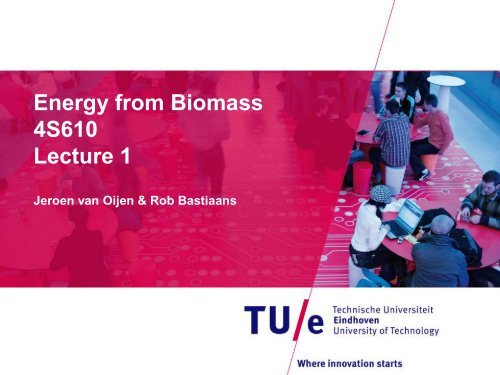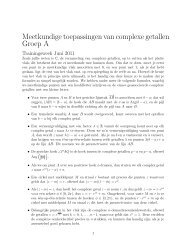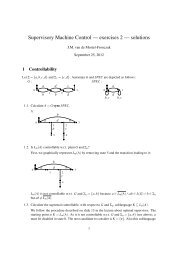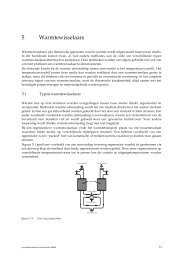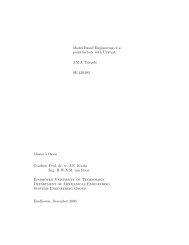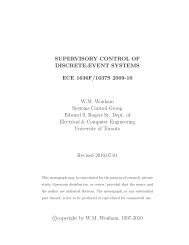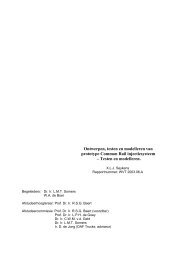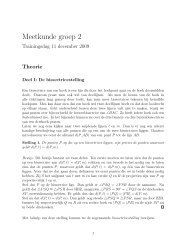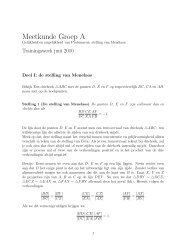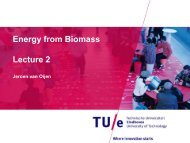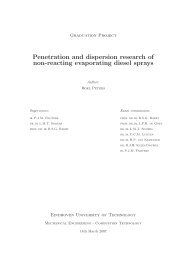Energy from Biomass Lecture 1 - Mechanical Engineering
Energy from Biomass Lecture 1 - Mechanical Engineering
Energy from Biomass Lecture 1 - Mechanical Engineering
Create successful ePaper yourself
Turn your PDF publications into a flip-book with our unique Google optimized e-Paper software.
<strong>Energy</strong> <strong>from</strong> <strong>Biomass</strong><br />
4S610<br />
<strong>Lecture</strong> 1<br />
Jeroen van Oijen & Rob Bastiaans
<strong>Lecture</strong>rs <strong>Energy</strong> <strong>from</strong> <strong>Biomass</strong><br />
Jeroen van Oijen<br />
j.a.v.oijen@tue.nl<br />
GEM-N 1.48, T: 3133<br />
Rob Bastiaans<br />
r.j.m.bastiaans@tue.nl<br />
GEM-N 1.46, T: 4836<br />
/ <strong>Mechanical</strong> <strong>Engineering</strong> 13-11-2012 PAGE 1
Today<br />
• Combustion technology and biomass<br />
• Course info, philosophy, planning, info<br />
• Greenhouse effect<br />
• Qualitative, evidence<br />
• Quantitative<br />
• Carbon Cycle<br />
• Policies<br />
• Resources<br />
• Potential<br />
/ <strong>Mechanical</strong> <strong>Engineering</strong> 13-11-2012 PAGE 2
Course material<br />
• OASE<br />
• Website<br />
http://w3.wtb.tue.nl/en/research/research_groups/combus<br />
tion_technology/education/energy_<strong>from</strong>_biomass/<br />
• Reader<br />
• <strong>Lecture</strong>s<br />
• Practical work<br />
/ <strong>Mechanical</strong> <strong>Engineering</strong> 13-11-2012 PAGE 3
<strong>Mechanical</strong> <strong>Engineering</strong> 13-11-2012 PAGE 4
Combustion technology<br />
Combustion technology is<br />
Technology dedicated to development of new methods and<br />
improvement of existing methods and equipment used for efficient<br />
and clean conversion of ‘chemical energy’ in the form of fuel to<br />
another usable form like heat, electrical energy, and kinetic energy,<br />
or… (another) fuel.<br />
So, it includes biomass!<br />
/ <strong>Mechanical</strong> <strong>Engineering</strong> 13-11-2012 PAGE 5
Combustion technology<br />
• Before 1970: Mainly empirical<br />
• After 1970: Combustion science<br />
• Development of advanced measurement techniques<br />
• Proper computation techniques / increasing computer<br />
speed<br />
• Social need<br />
− Clean<br />
− Efficient<br />
• Oil crisis<br />
• Depletion/greenhouse problems<br />
/ <strong>Mechanical</strong> <strong>Engineering</strong> 13-11-2012 PAGE 6
Combustion technology and biomass<br />
• Combustion is about<br />
• Physical transport phenomena<br />
• Chemical conversion<br />
• Efficiency<br />
• Emissions<br />
• Analysis and insight in processes<br />
• Not about:<br />
• detailed construction aspects<br />
• strategic / political choices<br />
/ <strong>Mechanical</strong> <strong>Engineering</strong> 13-11-2012 PAGE 7
Combustion Technology @ TU/e<br />
• Experimental, numerical, applied research<br />
• Applications<br />
• Domestic burners<br />
• Internal combustion engines<br />
• Gas turbines<br />
• Industrial furnaces<br />
• Gaseous and liquid fuels<br />
• <strong>Biomass</strong> challenge: solid fuel<br />
/ <strong>Mechanical</strong> <strong>Engineering</strong> 13-11-2012 PAGE 8
<strong>Biomass</strong> research at CT<br />
• EU project OPTICOMB<br />
• Optimization of biomass combustion systems<br />
• 2003 - 2007<br />
• Partners<br />
• TNO<br />
• VT-TU Graz<br />
• CT-TU/e<br />
• Vyncke, …<br />
/ <strong>Mechanical</strong> <strong>Engineering</strong> 13-11-2012 PAGE 9
OPTICOMB<br />
• Goal: Increase (fuel) flexibility of biomass<br />
combustion installations<br />
• Control<br />
• Guide lines NOx and<br />
CO reduction<br />
• Efficiency increase<br />
• Design rules<br />
• Test of new design<br />
• Crucial role CFD,<br />
chemistry model,<br />
NO formation<br />
/ <strong>Mechanical</strong> <strong>Engineering</strong> 13-11-2012 PAGE 10
OPTICOMB Task TU/e 1<br />
<strong>Biomass</strong> fuel characterization with grid reactor<br />
Result<br />
• Chemical kinetics parameters<br />
for biomass fuel<br />
• Model for combustion of<br />
small particles<br />
/ <strong>Mechanical</strong> <strong>Engineering</strong> 13-11-2012 PAGE 11
OPTICOMB Task TU/e 2<br />
• CFD combustion model of gas phase products<br />
• Simplified NOx model<br />
• Coupling with fixed bed<br />
boundary condition<br />
• Verification<br />
• Case studies<br />
• Different fuels<br />
• Different geometry<br />
/ <strong>Mechanical</strong> <strong>Engineering</strong> 13-11-2012 PAGE 12
Articles in <strong>Energy</strong> & Fuel<br />
10 most cited<br />
articles <strong>from</strong> first<br />
3 months of 2010<br />
/ <strong>Mechanical</strong> <strong>Engineering</strong> 13-11-2012 PAGE 13
The course: global structure<br />
• Introduction<br />
• Resources and potential<br />
• <strong>Biomass</strong> characteristics<br />
• Basic conversion processes<br />
• <strong>Biomass</strong> conversion systems<br />
• Emissions<br />
Background<br />
Processes<br />
Systems<br />
/ <strong>Mechanical</strong> <strong>Engineering</strong> 13-11-2012 PAGE 14
The course: global structure<br />
• Transport and chemistry<br />
• Idealized reactors<br />
• Single particle conversion<br />
• Fixed bed conversion<br />
Fundamental<br />
Modeling<br />
Analysis<br />
• Guest lecture <strong>from</strong> industry<br />
• Practical work<br />
/ <strong>Mechanical</strong> <strong>Engineering</strong> 13-11-2012 PAGE 15
Course content<br />
• Background of biomass<br />
• Basics of thermal conversion<br />
• Technical systems<br />
• Physical transport processes and chemistry<br />
• Easy for ME and hard for SET<br />
Not reflected in end marks!<br />
/ <strong>Mechanical</strong> <strong>Engineering</strong> 13-11-2012 PAGE 16
Philosophy<br />
<strong>Biomass</strong> conversion: presently trial and error<br />
Therefore, vast amount of conversion systems, for<br />
every fuel and end-use<br />
Here:<br />
• Basic principles and processes<br />
• Decision making based on analysis / calculations<br />
/ <strong>Mechanical</strong> <strong>Engineering</strong> 13-11-2012 PAGE 17
<strong>Lecture</strong>s<br />
Week Date Subject Chptr. <strong>Lecture</strong>r<br />
46 13-11 General introduction, greenhouse effect, Kyoto protocol, biomass<br />
resources.<br />
1 Van Oijen<br />
46 15-11 <strong>Biomass</strong> composition and properties, ultimate/proximate<br />
analysis.<br />
47 20-11 Thermal conversion processes<br />
(pyrolysis/gasification/combustion).<br />
47 22-11 Modelling conversion processes,<br />
application to simple reactors.<br />
2 Van Oijen<br />
3 Van Oijen<br />
4 Bastiaans<br />
48 27-11 Conversion of spherical particles. 4 Bastiaans<br />
48 29-11 Front propagation in fixed bed reactors. A Van Oijen<br />
49 4-12 Emissions and reduction measures, NO x and tar.<br />
Guest lecture.<br />
49 6-12 <strong>Biomass</strong> conversion systems<br />
(small scale/large scale).<br />
6 Van Oijen<br />
Guest<br />
5 Bastiaans<br />
/ <strong>Mechanical</strong> <strong>Engineering</strong> 13-11-2012 PAGE 18
Practical work<br />
Numerical study of biomass conversion in a fixed bed<br />
Numerical exercises<br />
Time: Thursday 8:45-11:30<br />
Place: Gemini-Zuid 3a.05<br />
Instructors: J.A. van Oijen, R.J.M. Bastiaans and A. Donini<br />
Week Date Subject<br />
50 13-12 Introduction to Comsol and first simulations<br />
51 20-12 Simulating reaction front propagation in fixed bed.<br />
2 10-1 Idem.<br />
Groups of 2 students write a report<br />
Results count for 1/3 of final grade<br />
/ <strong>Mechanical</strong> <strong>Engineering</strong> 13-11-2012 PAGE 19
Examination<br />
Time: Wednesday, January 22, 2013, 9:00-12:00<br />
Place: To be determined<br />
Observer: J.A. van Oijen<br />
No books/notes allowed<br />
Bring a calculator<br />
Report: Before examination<br />
/ <strong>Mechanical</strong> <strong>Engineering</strong> 13-11-2012 PAGE 20
How to study<br />
Read reader (slides <strong>from</strong> last year) before the lecture<br />
Follow the lecture<br />
Study the lecture (exercise exam questions)<br />
if needed take reader; or ask lecturers<br />
Material in lectures is leading in the assessment<br />
/ <strong>Mechanical</strong> <strong>Engineering</strong> 13-11-2012 PAGE 21
Information on biomass<br />
Internet<br />
• Vast source of information<br />
• Many organizations<br />
• Up-to-date information<br />
• Validity<br />
Dutch: VROM, RIVM, CBS, ECN, Verantwoord Groen,<br />
etc. etc.<br />
International: EU, UN, WEC, IEA, OECD, IPCC, WMO,<br />
DOE, etc. etc.<br />
/ <strong>Mechanical</strong> <strong>Engineering</strong> 13-11-2012 PAGE 22
Information<br />
Books<br />
• Generally better than internet<br />
• At least edited<br />
• Not always up-to-date<br />
• Handbook <strong>Biomass</strong> Combustion and Co-firing, van Loo and<br />
Koppejan, eds., Twente University Press.<br />
• Handbook <strong>Biomass</strong> Gasification, Knoef editor, BTG, <strong>Biomass</strong><br />
Technology Group<br />
• Handbook of <strong>Biomass</strong> Downdraft <strong>Energy</strong> Systems, Reed & Das.<br />
• Thermochemical Processing of <strong>Biomass</strong>, Brown editor.<br />
/ <strong>Mechanical</strong> <strong>Engineering</strong> 13-11-2012 PAGE 23
Introduction<br />
Global warming and biomass<br />
• Renewable energy<br />
• Greenhouse effect<br />
• Carbon cycle<br />
• Policies<br />
• <strong>Biomass</strong> usage<br />
/ <strong>Mechanical</strong> <strong>Engineering</strong> 13-11-2012 PAGE 24
<strong>Biomass</strong> combustion<br />
Fire <strong>from</strong><br />
biomass<br />
1 million<br />
Year ago<br />
/ <strong>Mechanical</strong> <strong>Engineering</strong> 13-11-2012 PAGE 25
What is biomass<br />
<strong>Biomass</strong> regulation 2001/77/EG sustainable energy:<br />
‘the biological degradable fraction of products,<br />
wastes and residues <strong>from</strong> agriculture (including<br />
animal and vegetable materials), forestry and the<br />
biological degradable fraction of industrial and<br />
household wastes’<br />
/ <strong>Mechanical</strong> <strong>Engineering</strong> 13-11-2012 PAGE 26
What about oil and gas<br />
• Well defined,<br />
high energy content,<br />
easy to use, etc.<br />
/ <strong>Mechanical</strong> <strong>Engineering</strong> 13-11-2012 PAGE 27
However…<br />
/ <strong>Mechanical</strong> <strong>Engineering</strong> 13-11-2012 PAGE 28
<strong>Energy</strong> scenario WEA (UN)<br />
/ <strong>Mechanical</strong> <strong>Engineering</strong> 13-11-2012 PAGE 29
Why biomass<br />
• Can be sustainable<br />
• Short carbon cycle<br />
• Considered to be CO 2 neutral<br />
• No additional greenhouse effect<br />
• Large scale availability<br />
• Independent energy production<br />
• Cheaper than oil (if all costs are included)<br />
/ <strong>Mechanical</strong> <strong>Engineering</strong> 13-11-2012 PAGE 30
The greenhouse effect<br />
/ <strong>Mechanical</strong> <strong>Engineering</strong> 13-11-2012 PAGE 31
The greenhouse effect<br />
Evidence 1<br />
/ <strong>Mechanical</strong> <strong>Engineering</strong> 13-11-2012 PAGE 32
The greenhouse effect<br />
Evidence 2<br />
/ <strong>Mechanical</strong> <strong>Engineering</strong> 13-11-2012 PAGE 33
The greenhouse effect<br />
Evidence 3<br />
/ <strong>Mechanical</strong> <strong>Engineering</strong> 13-11-2012 PAGE 34
The greenhouse effect<br />
Evidence 4<br />
/ <strong>Mechanical</strong> <strong>Engineering</strong> 13-11-2012 PAGE 35
The greenhouse effect<br />
Evidence 5<br />
/ <strong>Mechanical</strong> <strong>Engineering</strong> 13-11-2012 PAGE 36
Different models<br />
Greenhouse effects predictions<br />
Anthropogeneous<br />
temperature<br />
increase<br />
/ <strong>Mechanical</strong> <strong>Engineering</strong> 13-11-2012 PAGE 37
Discussion<br />
We must decrease CO 2 emissions.<br />
What is prefered:<br />
1) An engine with high CO 2 emission<br />
per kg of fuel<br />
2) An engine with low CO 2 emission<br />
per kg of fuel<br />
/ <strong>Mechanical</strong> <strong>Engineering</strong> 13-11-2012 PAGE 38
How the greenhouse effect works
How the greenhouse effect works
How the greenhouse effect works
How the greenhouse effect works
How the greenhouse effect works
How the greenhouse effect works
How the greenhouse effect works
How the greenhouse effect works
How the greenhouse effect works
How the greenhouse effect works<br />
Global warming<br />
• We had a qualitative view<br />
• But can we quantify<br />
• Let us do an estimation!<br />
• How
How the greenhouse effect works<br />
Global warming<br />
• How<br />
• Based on radiation equilibrium<br />
• The sun radiates to the earth: S=1368 W/m 2<br />
• The earth radiates to the universe
How the greenhouse effect works<br />
Global warming<br />
• Albedo A, incoming radiation is effective for (1-A)<br />
• Albedo due to earth surface and atmosphere<br />
• Equation for reception of solar energy
How the greenhouse effect works<br />
<br />
<br />
( 1<br />
A) SR<br />
2
How the greenhouse effect works
How the greenhouse effect works<br />
Global warming<br />
• Equation for radiation <strong>from</strong> earth to the universe<br />
<br />
A T<br />
4
How the greenhouse effect works<br />
In:<br />
<br />
<br />
( 1<br />
A) SR<br />
2<br />
Out:<br />
<br />
4R 2<br />
T<br />
4
How the greenhouse effect works<br />
How does it work<br />
Radiation equilibrium: 255 K (-18 ℃)<br />
The radiation trap increases the temperature<br />
Add atmosphere in the model: 303 K (30 ℃)<br />
Add emissivity coefficient: 290 K (17 ℃)<br />
Real value: ~ 15 ℃
The carbon cycle: Photosynthesis<br />
/ <strong>Mechanical</strong> <strong>Engineering</strong> 13-11-2012 PAGE 56
The carbon cycle<br />
/ <strong>Mechanical</strong> <strong>Engineering</strong> 13-11-2012 PAGE 57
The carbon cycle<br />
/ <strong>Mechanical</strong> <strong>Engineering</strong> 13-11-2012 PAGE 58
Not new…<br />
But: Risk = Probability x Consequence<br />
/ <strong>Mechanical</strong> <strong>Engineering</strong> 13-11-2012 PAGE 59
<strong>Biomass</strong>: harvesting sunlight<br />
10.000x annual need<br />
10x annual need<br />
/ <strong>Mechanical</strong> <strong>Engineering</strong> 13-11-2012 PAGE 60
Use of biomass<br />
• Direct combustion (heat)<br />
• Gasification (solid to gas)<br />
• Combustion<br />
• Conversion:<br />
• Liquid fuels (FT diesel)<br />
• Hydrogen<br />
/ <strong>Mechanical</strong> <strong>Engineering</strong> 13-11-2012 PAGE 61
<strong>Biomass</strong> carbon cycle<br />
CO 2<br />
Fuel<br />
/ <strong>Mechanical</strong> <strong>Engineering</strong> 13-11-2012 PAGE 62
<strong>Biomass</strong> energy plant<br />
Not much different <strong>from</strong> coal-fired power plant<br />
/ <strong>Mechanical</strong> <strong>Engineering</strong> 13-11-2012 PAGE 63
Policies<br />
The Kyoto protocol (COP3 1997)<br />
• Legally binding emission targets for Annex I<br />
(developed) countries<br />
• Reduction of greenhouse gases by 5% in 2008-2012<br />
• Reference year is 1990<br />
• Basket contains CO 2 , CH 4 , N 2 O, HFC’s , PFC’s, and<br />
SF 6<br />
/ <strong>Mechanical</strong> <strong>Engineering</strong> 13-11-2012 PAGE 64
Kyoto protocol<br />
• Europe: -8%<br />
• The Netherlands: -6%<br />
• Possibility for “emissions trading”<br />
• Into force if 55 parties representing 55% of 1990 CO 2<br />
emissions agree<br />
• Russia ratified in February 2005<br />
• Official at conference Montreal, November 2005<br />
/ <strong>Mechanical</strong> <strong>Engineering</strong> 13-11-2012 PAGE 65
Kyoto protocol for the Netherlands<br />
• 6% reduction<br />
• 50% domestic<br />
• 50% foreign, “emission trading”<br />
• Acquisition of 50 billion ton CO2<br />
equivalents @ 4-5 € → 400-500 M€<br />
• The Dutch seemed to be on track…<br />
• New negotiations failed at Copenhagen<br />
/ <strong>Mechanical</strong> <strong>Engineering</strong> 13-11-2012 PAGE 66
Greenhouse gas emissions NL<br />
/ <strong>Mechanical</strong> <strong>Engineering</strong> 13-11-2012 PAGE 67
European policy<br />
• CO2 trading scheme<br />
• 20-20-20 policy<br />
• 20 % renewables (of which 40% biomass)<br />
• 20 % reduction in energy use<br />
• 20 % less CO2 emissions (1990)<br />
• Point of view: not exceed 2K temperature increase<br />
/ <strong>Mechanical</strong> <strong>Engineering</strong> 13-11-2012 PAGE 68
Resources and potential<br />
/ <strong>Mechanical</strong> <strong>Engineering</strong> 13-11-2012 PAGE 69
Facts and figures<br />
• Global energy consumption:<br />
• 400 exajoules<br />
• Annual production of biomatter:<br />
• 220 billion oven dry tons<br />
• 4500 exajoules<br />
• Theoretically harvestable bioenergy:<br />
• 2900 exajoules<br />
• Technically available on sustainable basis:<br />
• 270 exajoules<br />
/ <strong>Mechanical</strong> <strong>Engineering</strong> 13-11-2012 PAGE 70
<strong>Biomass</strong> challenge<br />
<strong>Biomass</strong> challenge is not availability, but<br />
sustainable management, conversion and delivery<br />
to the market.<br />
The Stone Age did not end for lack of stone<br />
and the oil industry will end long before the<br />
world runs out of oil (Sheikh Zaki Yamani)<br />
/ <strong>Mechanical</strong> <strong>Engineering</strong> 13-11-2012 PAGE 71
Facts and figures<br />
• Current bio-energy consumption:<br />
• 50 exajoules (11%)<br />
• Developing countries (China, India)<br />
• <strong>Biomass</strong> 35% of their total<br />
• Poorest countries<br />
• <strong>Biomass</strong> 90% of their total<br />
• Traditional, non-commercial forms<br />
/ <strong>Mechanical</strong> <strong>Engineering</strong> 13-11-2012 PAGE 72
Perception and problems<br />
Fuel of the past<br />
• Associations with poverty<br />
• High pollution<br />
• Health problems in developing countries<br />
• Low efficiency<br />
• High water content<br />
• Quality unpredictable<br />
• Land use for energy crops<br />
• Water use<br />
/ <strong>Mechanical</strong> <strong>Engineering</strong> 13-11-2012 PAGE 73
A definition of biomass<br />
<strong>Biomass</strong> regulation 2001/77/EG sustainable energy:<br />
‘the biological degradable fraction of products,<br />
wastes and residues <strong>from</strong> agriculture (including<br />
animal and vegetable materials), forestry and the<br />
biological degradable fraction of industrial and<br />
household wastes’<br />
/ <strong>Mechanical</strong> <strong>Engineering</strong> 13-11-2012 PAGE 74
Classification (WEA)<br />
• Vegetable/plant biomass<br />
• Woody<br />
• Non-woody<br />
• Processed waste<br />
• Animal biomass<br />
• Municipal solid waste<br />
/ <strong>Mechanical</strong> <strong>Engineering</strong> 13-11-2012 PAGE 75
Municipal solid waste<br />
• 1-2 kg solid waste per capita every day in<br />
industrialized countries<br />
• <strong>Energy</strong> contents: 4-13 MJ/kg<br />
• <strong>Energy</strong> conversion is profitable<br />
• Waste incineration requires tight air pollution<br />
abatement<br />
/ <strong>Mechanical</strong> <strong>Engineering</strong> 13-11-2012 PAGE 76
Resources<br />
• Residues/wastes <strong>from</strong><br />
• Agriculture (straw)<br />
• Forestry (treetops, branches)<br />
• Wood industry (bark, sawdust)<br />
• Food industry (olive stones)<br />
• <strong>Energy</strong> crops (miscanthus, switch grass)<br />
/ <strong>Mechanical</strong> <strong>Engineering</strong> 13-11-2012 PAGE 77
Residues and wastes<br />
• By-products of agro-industry and forestry<br />
• <strong>Energy</strong> content is more than 1/3 of global<br />
commercial energy use<br />
• 30% is recoverable<br />
• Limited by<br />
• Impracticability of recovering<br />
• Need to leave residues at the site (fertilization)<br />
/ <strong>Mechanical</strong> <strong>Engineering</strong> 13-11-2012 PAGE 78
<strong>Energy</strong> crops<br />
• Food crops (sugar cane, sugar beet, wheat,<br />
rapeseed)<br />
1 st generation biomass<br />
• Woody or grassy materials, (miscanthus,<br />
hemp, grass, poplar, eucalyptus, etc.)<br />
2 nd generation biomass
Potential of energy plantations<br />
Large part of biomass supply, but<br />
• Availability of land<br />
• Regional distribution<br />
• Productivity of the land<br />
• Environmental implications<br />
• Performance of conversion technologies<br />
/ <strong>Mechanical</strong> <strong>Engineering</strong> 13-11-2012 PAGE 80
Global land-use pattern<br />
Gha<br />
% of total<br />
WEA 2000<br />
Cropland 1.5 11<br />
Forests 4.2 32<br />
Pastures 3.4 26<br />
Other 4.0 31<br />
1.6-1.8 rainfed<br />
Gha = 10 13 m 2<br />
Total 13.1 100<br />
/ <strong>Mechanical</strong> <strong>Engineering</strong> 13-11-2012 PAGE 81
Projected biomass energy potential<br />
Gha<br />
WEA 2000<br />
Cropland potential in 1990 2.6<br />
Cultivated in 1990 0.9<br />
Additional required in 2050 0.4<br />
Extra for biomass 1.3<br />
Extra bio-energy<br />
400 EJ<br />
15 ton/ha<br />
20 GJ/ton<br />
/ <strong>Mechanical</strong> <strong>Engineering</strong> 13-11-2012 PAGE 82
World <strong>Energy</strong> Outlook 2006<br />
• “<strong>Energy</strong> farming on current agricultural land could<br />
contribute up to 700 exajoule per year of biomass<br />
energy by 2050 without jeopardising the world’s food<br />
supply, forests or biodiversity – assuming very rapid<br />
technological progress.”<br />
/ <strong>Mechanical</strong> <strong>Engineering</strong> 13-11-2012 PAGE 83
Water resources<br />
• Supply of fresh water may<br />
become a limiting factor<br />
• Availability for biomass<br />
production has not been<br />
addressed in detail<br />
• Even without biomass<br />
production, water shortages<br />
are possible for half the world’s<br />
population in 2025<br />
/ <strong>Mechanical</strong> <strong>Engineering</strong> 13-11-2012 PAGE 84
Productivity of land<br />
• Production depends on climate, soil, and<br />
management conditions<br />
• Net energy yield 30-500 GJ/ha/year<br />
• Perennial crops annual crops<br />
• Irrigation, fertiliser, genetics<br />
/ <strong>Mechanical</strong> <strong>Engineering</strong> 13-11-2012 PAGE 85
Transport of biomass<br />
• Transport costs 0.5 MJ/ton/km<br />
• Distance limited to 100 km<br />
• Surface still 10 5 ha<br />
• Enough supply for hundreds<br />
of megawatts<br />
• Transport by sea<br />
• Latin America to Europe:<br />
energy loss < 10%<br />
• Common practice (wood for<br />
paper/pulp)<br />
/ <strong>Mechanical</strong> <strong>Engineering</strong> 13-11-2012 PAGE 86
Environmental implications<br />
• Water use<br />
• Erosion<br />
• Perennials (willow, poplar, eucalyptus)<br />
• Agrochemicals / Pesticides<br />
• Perennials 10x less than for food crops<br />
• Nutrients / Fertiliser<br />
• Biological fertilisers<br />
• Recycling of ashes<br />
/ <strong>Mechanical</strong> <strong>Engineering</strong> 13-11-2012 PAGE 87
Environmental implications<br />
• Biodiversity and landscape<br />
• Only a risk for virgin forests<br />
• Not for degraded lands or excess agricultural lands<br />
• Health risks<br />
• Fire<br />
• Diseases<br />
• Conversion and end use<br />
• Clean combustion<br />
/ <strong>Mechanical</strong> <strong>Engineering</strong> 13-11-2012 PAGE 88
Economy of biomass<br />
• Profitable when cheap or negative cost residues or<br />
wastes are available<br />
• Plantation biomass production costs<br />
• 1.5-2.0 $/GJ in developing countries<br />
• 4 $/GJ in NW Europe<br />
• 1.5-2.0 $/GJ for US in 2020<br />
• Electricity production costs<br />
• 0.05 $/kWh using current technology<br />
/ <strong>Mechanical</strong> <strong>Engineering</strong> 13-11-2012 PAGE 89
Economy of biomass<br />
Not yet competitive, but…<br />
• Technology will improve<br />
• Costs will go down<br />
• Fossil fuels become more expensive<br />
• Low investment costs:<br />
• Co-firing with coal or natural gas<br />
/ <strong>Mechanical</strong> <strong>Engineering</strong> 13-11-2012 PAGE 90
Summary and conclusions<br />
• Modern problems:<br />
• <strong>Energy</strong> shortage<br />
• Environmental problem, greenhouse effect<br />
• <strong>Biomass</strong> might be a solution for both (why)<br />
• This is about thermal biomass conversion<br />
• Potential seems to be promising<br />
• Economy seems to become promising<br />
• Policies are important<br />
/ <strong>Mechanical</strong> <strong>Engineering</strong> 13-11-2012 PAGE 91
Next time<br />
• Properties of biomass<br />
• Chemical<br />
• Physical<br />
• <strong>Mechanical</strong><br />
• Determination of these properties<br />
• How to use them in decision making<br />
• Prelude to conversion processes<br />
/ <strong>Mechanical</strong> <strong>Engineering</strong> 13-11-2012 PAGE 92
Questions<br />
/ <strong>Mechanical</strong> <strong>Engineering</strong> 13-11-2012 PAGE 93


